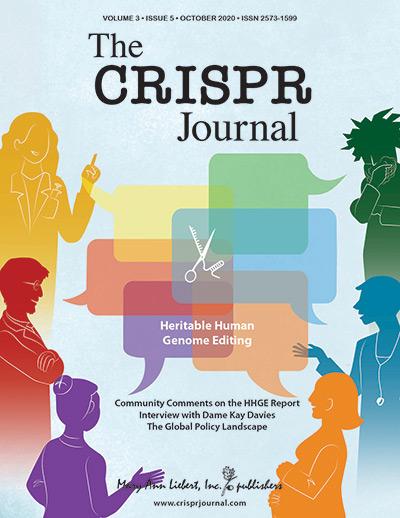
Credit: Mary Ann Liebert, Inc., publishers
The CRISPR Journal announces the publication of its December 2020 issue, a Special Issue on Expanding the CRISPR Toolbox. The Journal is dedicated to validating and publishing outstanding research and commentary on all aspects of CRISPR and gene editing, including CRISPR biology, technology, and genome editing, and commentary and debate of key policy, regulatory, and ethical issues affecting the field. The Journal, led by Editor-in-Chief Rodolphe Barrangou, PhD (North Carolina State University) and Executive Editor Kevin Davies, PhD is published bimonthly in print and online. Visit The CRISPR Journal website for more information.
This press release is copyright Mary Ann Liebert, Inc. Its use is granted only for journalists and news media receiving it directly from The CRISPR Journal. For full-text copies of articles or to arrange interviews with Dr. Barrangou, Dr. Davies, authors, or members of the editorial board, contact Kathryn Ryan at the Publisher.
1 Special Issue: Expanding the CRISPR Toolbox
The December 2020 issue of The CRISPR Journal features a special collection of eight research articles under the theme: “Expanding the CRISPR Toolbox.” The collection includes articles from CRISPR Therapeutics, Metagenomi, and research groups in Denmark and China. The guest editor is Dr. Stanley Qi (Stanford University).
As the Journal’s chief editor Rodolphe Barrangou notes in this issue’s editorial: “This series captures many such developments, notably the mining of novel Type V-A Cas12 enzymes from a group at Metagenomi. The collection also features new in silico tools that enable CRISPR-Cas system identification and practical exploitation from groups in Denmark and China.” In addition to tool development, articles include advances in guide design and selection (from China), Cas fusion to effectors (from the US), off-target method assessments (CRISPR Therapeutics), and applications for DNA detection and exogenous DNA integration.
Contact: Rodolphe Barrangou (NCSU/The CRISPR Journal) or Stanley Qi (Stanford University).
2 Assessing CRISPR Off-Targets
Understanding the scope and prevalence of off-target genome editing using CRISPR-Cas9 is a critical undertaking to ensure the safety of the technology in patients. In the lead article in the “Expanding the CRISPR Toolbox” special issue, researchers from CRISPR Therapeutics present a meticulous comparison of three popular “off-target site nomination assays.” After treating HEK293T cells with Cas9 and various guide RNAs, the authors compared the performance of three homology-independent off-target nomination methods: the cell-based assay GUIDE-seq, and the biochemical assays CIRCLE-seq and SITE-seq. While the three methods performed similarly, there were significant differences in the total number of sites nominated. Nevertheless, the authors conclude that all three methods provide reliable and “comprehensive assessment of off-target activity.”
Contact: Andrew Kernytsky (CRISPR Therapeutics)
3 Mining for New CRISPR Tools
Cas12a enzymes are increasingly gaining popularity as go-to tools in the CRISPR toolbox. Conducting a large-scale metagenomic analysis including uncultivated organisms, Christopher Brown and coworkers at Metagenomi in California have identified novel families of Type V-A CRISPR nucleases and initiated their analysis in gene editing platforms. The novel nucleases display extensive protein variation and can be programmed by a single-guide RNA. Moreover, some exhibit unexpected protospacer adjacent motif (PAM) diversity. These systems, the authors suggest, will facilitate a variety of genome-engineering applications including gene and cell therapies.
Contact: Christopher Brown (Metagenomi)
4 Isolated and Orphan CRISPR Arrays
The study of CRISPR arrays continues apace, revealing some surprises along the way. In a new report in The CRISPR Journal, veteran bioinformatician Eugene Koonin and colleagues at the National Center for Biotechnology Information (NCBI) have surveyed more than 13,000 microbial genome sequences looking for isolated CRISPR arrays that are not adjacent to Cas genes. Using a bioinformatic pipeline, the team identified 116 unique bona fide arrays distributed across 89 clusters, for which repeats show no similarity to known CRISPR sequences. These are considered ”orphans” until the associated Cas gene is discovered.
Contact: Eugene Koonin (NCBI)
###
Media Contact
Kathryn Ryan
[email protected]




